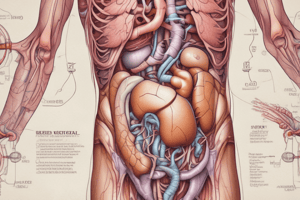Podcast
Questions and Answers
What is the primary function of the urinary system?
What is the primary function of the urinary system?
- Producing blood cells
- Maintaining fluid and electrolyte balance (correct)
- Regulating body temperature
- Aiding in digestion
Which organ in the urinary system is responsible for filtering blood and producing urine?
Which organ in the urinary system is responsible for filtering blood and producing urine?
- Renal pelvis
- Urethra
- Bladder
- Kidneys (correct)
Where is urine stored before being eliminated from the body?
Where is urine stored before being eliminated from the body?
- Prostate gland
- Renal pelvis
- Ureters
- Bladder (correct)
What is the function of nephrons in the kidneys?
What is the function of nephrons in the kidneys?
Which structure in the male urinary system does the urethra pass through?
Which structure in the male urinary system does the urethra pass through?
Where does the urethra lead to in females?
Where does the urethra lead to in females?
What does the specific gravity of urine measure in urinalysis?
What does the specific gravity of urine measure in urinalysis?
What may be indicated by dark or cloudy urine during urinalysis?
What may be indicated by dark or cloudy urine during urinalysis?
Which health condition can cause a decrease in urine pH according to the provided information?
Which health condition can cause a decrease in urine pH according to the provided information?
What might the presence of proteins in urine indicate during urinalysis?
What might the presence of proteins in urine indicate during urinalysis?
Why is understanding the anatomy of the urinary system important for healthcare professionals?
Why is understanding the anatomy of the urinary system important for healthcare professionals?
During urinalysis, what can a strong odor of urine potentially indicate?
During urinalysis, what can a strong odor of urine potentially indicate?
Flashcards are hidden until you start studying
Study Notes
The human urinary system is a complex network of organs and structures that work together to maintain fluid and electrolyte balance, remove waste products, and regulate the body's pH levels. Understanding the anatomy of the urinary system is crucial for comprehending the process of urinalysis, which is a diagnostic test that involves examining various aspects of urine to evaluate the health of the kidneys and urinary tract.
Anatomy of the Urinary System
The urinary system consists of the kidneys, ureters, bladder, and urethra. The kidneys are two bean-shaped organs located in the lower back, responsible for filtering blood and producing urine. Each kidney is divided into several lobes, containing millions of small structures called nephrons. Nephrons are responsible for filtering blood and producing urine, which is then collected in the renal pelvis, a funnel-shaped cavity that leads to the ureters.
The ureters are thin, tube-like structures that connect the kidneys to the bladder. They transport urine from the kidneys to the bladder, where it is stored until it is eliminated from the body. The bladder is a muscular sac located in the pelvic cavity, which can expand to store urine and contract to expel it through the urethra.
The urethra is the final part of the urinary system, serving as the conduit for urine to exit the body. In males, the urethra passes through the prostate gland and runs through the penis, while in females, it is shorter and leads to the exterior of the body.
Urinalysis
Urinalysis is a diagnostic test that involves analyzing urine for various components, such as color, odor, specific gravity, pH, and the presence of cells, casts, proteins, glucose, ketones, and bilirubin. The test can reveal a wide range of conditions, including kidney disease, urinary tract infections, diabetes, and liver disease.
During urinalysis, a urine sample is collected in a sterile container and analyzed for various parameters. The color, odor, and appearance of the urine can provide clues about the health of the kidneys and urinary tract. For example, cloudy or dark urine may indicate the presence of an infection or kidney stones. A strong odor may indicate a urinary tract infection or diabetes.
The specific gravity of urine is another important parameter in urinalysis. It measures the concentration of solutes in urine and can help determine the kidney's ability to conserve water and electrolytes. A low specific gravity may indicate a potential kidney problem or dehydration.
The pH of urine is also important in urinalysis, as it can indicate the presence of certain conditions. For example, a urinary tract infection can cause an increase in urine pH, while a kidney stone can cause a decrease in pH due to the acidic nature of the stone.
The presence of certain cells, casts, proteins, glucose, ketones, and bilirubin in urine can also provide valuable information about various health conditions. For example, the presence of red blood cells or white blood cells can indicate a kidney problem or a urinary tract infection, while the presence of protein can indicate kidney damage or liver disease.
In summary, understanding the anatomy of the urinary system and the various components of urinalysis is crucial for diagnosing and managing a wide range of health conditions. By analyzing urine for various parameters, healthcare professionals can gain valuable insights into the health of the kidneys and urinary tract, potentially leading to early detection and treatment of various conditions.
Studying That Suits You
Use AI to generate personalized quizzes and flashcards to suit your learning preferences.




